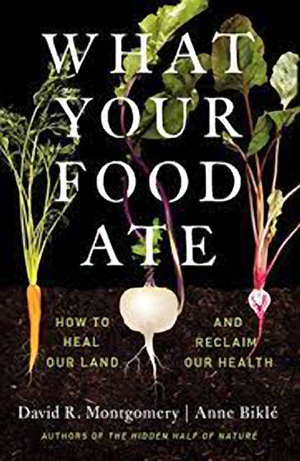
What Does Your Food Eat and Why Might that Matter?
by CRARS staff member Sheryl Karas. M.A.

Anyone concerned about high blood pressure, cholesterol, heart disease, cancer, type 2 diabetes, and dementia learns early on the importance of diet in maintaining or improving their health. Without doing much research at all you can find excellent sources like the American Heart Association(opens in new window), the Mayo Clinic,(opens in new window) and the American Cancer Society(opens in new window) who share numerous studies showing that antioxidants and other phytochemicals found in fruits and vegetables can prevent or lower the risk of all these conditions. It’s very clear that good health depends on good nutrition. What is less understood is how good nutrition might further depend on how our food is grown and raised. In other words, what did your food eat?
 Authors and married couple David R. Montgomery and Anne Biklé address this topic in detail in their latest book What Your Food Ate: How to Heal Our Land and Reclaim Our Health(opens in new window), soon to be published by W.W. Norton & Company in June 2022. (Ability to order ahead of publication is available.) Montgomery is a professor at the University of Washington who is internationally recognized in the field of geomorphology (the study of landforms and landform evolution). He has had a particular interest in soil degradation and erosion. Biklé is a biologist and environmental planner with professional experience in watershed restoration, environmental planning, and public health. Together they make the case that the health of our soil is the key to nutritious food and that the nutrient density in the food we eat is the key to a healthy life.
Authors and married couple David R. Montgomery and Anne Biklé address this topic in detail in their latest book What Your Food Ate: How to Heal Our Land and Reclaim Our Health(opens in new window), soon to be published by W.W. Norton & Company in June 2022. (Ability to order ahead of publication is available.) Montgomery is a professor at the University of Washington who is internationally recognized in the field of geomorphology (the study of landforms and landform evolution). He has had a particular interest in soil degradation and erosion. Biklé is a biologist and environmental planner with professional experience in watershed restoration, environmental planning, and public health. Together they make the case that the health of our soil is the key to nutritious food and that the nutrient density in the food we eat is the key to a healthy life.
Phytochemicals are NOT typically found in vitamin supplements so this is important information. They are chemical compounds that affect the color, flavor and odor of plant food which provide health benefits beyond what vitamins and minerals provide. Examples include polyphenols, flavonoids, phenolic acids, isoflavones, curcumin, carotenoids, phytosterols, and protease inhibitors. There are tens of thousands of phytochemicals that have been discovered, and the research showing their importance in human health is extensive. Unfortunately, how these compounds interact is not well-understood and it is not known what the recommended daily allowance would be for use in vitamin supplements or what combination of phytochemicals should be included. At this point in time, nutritionists(opens in new window) strongly recommend getting these nutrients from the food we eat.
What we do know is that many of these chemical compounds exist to provide protective benefits to the plant and that the content varies depending on growing conditions. That’s where Montgomery and Biklé come in. Their previous body of work together includes three books about the importance of soil health and agricultural practices that support or destroy it. For this book they wanted to explore whether the quality of the soil created using regenerative practices commonly used in the field of soil conservation resulted in higher nutritional quality in the food produced than conventional farming practices.
Unfortunately, they had trouble finding studies that included the elements they needed for their purposes. So together they devised their own research study with help from soil scientist Ray Archuleta, and ranchers Paul Brown and Jazmin Jordan.
Soil Health and Nutrient Density
The study(opens in new window), published on January 27, 2022, compared results from ten paired farm trials in North Carolina, Pennsylvania, Ohio, Iowa, Tennessee, Kansas, North Dakota, and Montana. The intent was to compare soil health and nutritional content of food grown on regenerative versus conventional farms and ranches growing the same type of food in neighboring locations. The regenerative farms chosen had all been using combined no-till, cover crops, and diverse crop rotations for at least 5-10 years. Some had used no-till methods or cover crops for longer. They also compared the nutritional content of beef and pork with a particular focus on fatty acids known for cardiovascular health benefits (conjugated linoleic acid as well as omega-3 and omega-6). Because the number of sites sampled, however, are small, this is considered a preliminary study. However, the results are so significant that the authors urge more studies be done to take the research further.
Soil organic matter is a significant indicator of good soil health. In this study, the regenerative farms averaged 3-12% soil organic matter while conventional farms averaged 2-5%. A second soil health testing method that measures the presence of microbial activity, the Haney scores, showed as much as a seven times difference between paired farms with the regenerative farms averaging scores of 11-30 while the conventional farms averaged 3-14.
The nutrient content of the foods tested on each farm varied substantially, but averaged across all the operations tested, crops from the regenerative farms had 34% more vitamin K, 15% more vitamin E, 14% more vitamin B1, and 17% more vitamin B2, as well as 15% more total carotenoids, 20% more total phenolics, 22% more total phytosterols, 11% more calcium, 16% more phosphorus, and 27% more copper. Some food crops showed more significant differences than others (cabbage, peas, and sorghum). Carrots from regenerative farms in Connecticut and California showed results that were strikingly high for total phenolics — 60% to 70% more than reported from conventional carrots obtained from New York supermarkets. It should also be noted, however, that not all the results were better for regenerative crops. Averaged over all crops tested, regenerative ones had less vitamin B6 and manganese. Regenerative soy had less Vitamin C and vitamins B1, B3, and B6 although it did have 22% more zinc. This indicates the need for more study across more types of food crops to see where the best impacts lie and whether other factors influence the results.
Still, these preliminary findings are worthy of note, and in terms of animal nutrition, results were even more impressive. Grass-fed beef from the regenerative farm where the animals grazed the cover crops, had six times more essential omega-3 fatty acids than the conventionally raised comparison (also a grass-fed operation). Regenerative pasture-raised pork with a diet supplemented with regeneratively raised ground grains (typically oats, peas, barley and flax) had more than nine times the omega-3 and three times the omega-6 than conventional pork raised in confinement and fed conventionally grown GMO corn and soybeans. Alpha linolenic acid (a type of omega 3) from the regenerative pork was 11 times as high.
The authors note that the results obtained from their study might be considered an upper range because regenerative farmers chosen to participate in the study were selected based on their success in developing and applying soil health building methods. They also note that all the regenerative farms were ones that had been conventionally farmed at one time and then were converted to regenerative practices. The soil they started with was much poorer than the soil they created with these methods, and the results were greatest with small scale no-till diversified-crop farms than with larger no-till grain-oriented operations.
The complexity of making comparisons between various soil profiles, the human microbiome, and other factors make it challenging to create rigorous linkages between soil health and human health say the researchers. But the results were definitive enough to warrant further investigation. In particular, the positive effect on phytochemicals known to reduce the risk of chronic diseases rampant in modern society is of particular significance—enough to say that what we feed our food might make a valuable impact on human health (as well as on the environment).
We just need to know more.
